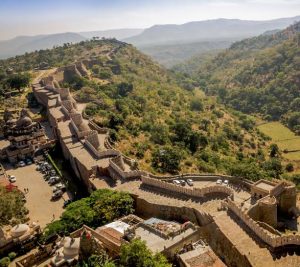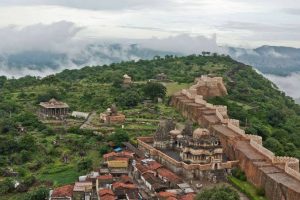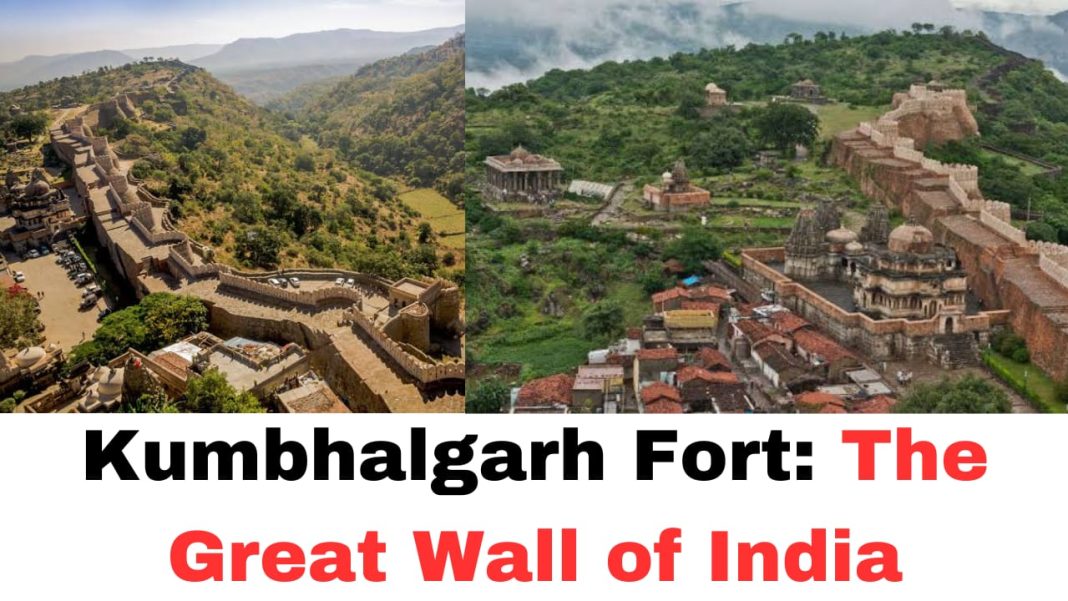Digital News Guru Rajasthan Desk:
Kumbhalgarh Fort
Perched majestically amidst the rugged Aravalli Hills in Rajasthan, Kumbhalgarh Fort stands as a remarkable symbol of Rajput valor, architectural ingenuity, and cultural heritage. Built in the 15th century by Maharana Kumbha, this UNESCO World Heritage Site is not only renowned for its robust fortifications but also for its role as a refuge in times of peril. Known as the “Great Wall of India,” its 36-kilometer-long wall is second only to the Great Wall of China, making it a monumental masterpiece of medieval architecture.
Historical Significance
Kumbhalgarh Fort was constructed in 1443 under the aegis of Maharana Kumbha, the ruler of the Mewar kingdom, a dynasty celebrated for its valor and independence. Designed to provide strategic defense, the fort served as a stronghold against invaders and a sanctuary for rulers of Mewar during turbulent times.

The fort’s most notable historical event is its association with Maharana Pratap, the legendary Rajput warrior. Kumbhalgarh was his birthplace and an integral part of his fight against the Mughal Empire. Over the centuries, the fort witnessed numerous battles, embodying the indomitable spirit of Rajputana.
Architectural Grandeur
Spread across 700 acres, Kumbhalgarh Fort is a stunning example of medieval Rajput military architecture, blending functionality with grandeur. Built on a hilltop at an altitude of 1,100 meters, the fort offers a commanding view of the surrounding landscape, making it a formidable defensive structure.
The Great Wall
The defining feature of Kumbhalgarh Fort is its massive wall, which snakes across the undulating terrain for 36 kilometers. The wall is up to 15 meters wide, allowing eight horses to ride abreast, and is fortified with bastions and watchtowers. This massive structure is often referred to as the “Great Wall of India” due to its scale and engineering brilliance.
Entrance and Gates
The fort’s entrance is guarded by the colossal Ram Pol, one of the seven gateways leading into the fort. Each gateway is intricately designed to deter enemies, with strategic chokepoints and sturdy construction.
Palaces and Temples
Kumbhalgarh Fort houses over 360 temples, including both Jain and Hindu shrines, reflecting the syncretic culture of the region. The Badal Mahal, or “Palace of Clouds,” located at the highest point of the fort, is an exquisite example of Rajput architecture. Adorned with intricate frescoes and airy rooms, it served as the royal residence and provides breathtaking views of the surrounding landscape.
Water Management
The fort’s builders demonstrated remarkable foresight in managing resources. A network of stepwells, reservoirs, and baoris (water tanks) ensured a constant supply of water, even during sieges. These systems underline the advanced engineering skills of the time.
Strategic Importance
Kumbhalgarh’s location and design made it an impregnable fortress. Nestled in the Aravalli Hills, the fort was surrounded by dense forests, now part of the Kumbhalgarh Wildlife Sanctuary, providing a natural defense. Its height and vantage points allowed defenders to spot advancing armies from a great distance, giving them ample time to prepare.
The fort’s design included clever traps and fortifications to counter attackers. Double walls and zigzag pathways at the entrances slowed down enemy forces, making assaults exceedingly difficult.
Cultural and Religious Heritage
Kumbhalgarh Fort is not just a military stronghold but also a spiritual hub. The numerous temples within its walls highlight the patronage of art and religion by the Rajput rulers. The Neelkanth Mahadev Temple, dedicated to Lord Shiva, houses a stunning six-foot-tall lingam and remains an active place of worship.

The presence of Jain temples underscores the harmonious coexistence of different religious communities under Rajput rule. The fort also played host to festivals and cultural events, serving as a center of royal life.
Tourism and Attractions
Today, Kumbhalgarh Fort is a popular tourist destination, drawing visitors from across the globe. The fort’s historical significance, combined with its breathtaking views and architectural marvels, makes it a must-visit site in Rajasthan.
Visitors can explore:
- Badal Mahal, with its stunning views of the Aravalli Hills.
- The 36-kilometer-long fort walls, ideal for photography and trekking.
- The fort’s temples, which offer a glimpse into the spiritual life of the Rajputs.
- Light and Sound Show, held every evening, narrating the fort’s history and the legacy of Maharana Kumbha.
For adventure enthusiasts, the Kumbhalgarh Wildlife Sanctuary offers an opportunity to witness the region’s diverse flora and fauna, including leopards, sloth bears, and birds.
Challenges and Preservation
Over the centuries, Kumbhalgarh Fort faced natural and human-made challenges, leading to partial deterioration of its structures. However, efforts by the Archaeological Survey of India (ASI) and UNESCO have been instrumental in preserving its glory. Restoration projects focus on maintaining the integrity of the walls, gates, and temples, ensuring the fort remains accessible to future generations.
Modern Relevance
Kumbhalgarh Fort is more than a historical relic; it is a source of pride and inspiration. The fort’s story of resilience and innovation resonates with modern audiences, offering lessons in leadership, perseverance, and sustainable architecture.
In the age of technology, Kumbhalgarh continues to attract history buffs, architects, and adventurers, serving as a bridge between the past and the present. Its recognition as a UNESCO World Heritage Site underscores its global significance and ensures its place in the annals of world heritage.
Conclusion
Kumbhalgarh Fort is a jewel in the crown of India’s architectural and cultural heritage. Its towering walls, magnificent temples, and strategic brilliance stand as a tribute to the ingenuity and courage of the Rajputs. As visitors traverse its ancient pathways, they are transported back in time, gaining a deeper appreciation for the fort’s historical and cultural significance.
Whether you’re drawn to its history, architecture, or panoramic views, a visit to Kumbhalgarh Fort is a journey into the heart of Rajasthan’s storied past—a timeless reminder of India’s glorious heritage and the enduring spirit of its people.
You May Also Read: Carterpuri: How a U.S. President’s Visit Changed a Haryana Village Forever








